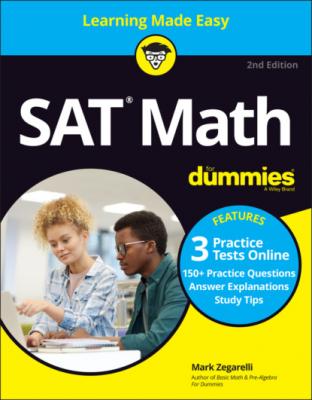ТОП просматриваемых книг сайта:
SAT Math For Dummies with Online Practice. Mark Zegarelli
Читать онлайн.Название SAT Math For Dummies with Online Practice
Год выпуска 0
isbn 9781119828389
Автор произведения Mark Zegarelli
Жанр Учебная литература
Издательство John Wiley & Sons Limited
When a decimal includes three or more decimal places, the decimal point remains in the resulting percentage. For example:
|
|
|
|
Changing percentages to decimals
Converting a percentage to a decimal reverses the process I describe in the previous section. To convert a percentage that doesn’t have a decimal point, introduce a decimal point just before the percent sign, then move it two places to the left and drop the percent sign. For example:
|
|
|
|
As you can see from this example, after changing a percentage to a decimal, you can safely drop unnecessary trailing zeros.
For percentages that are less than 10%, introduce one or more place-holding zeros as needed into the decimal that you create. For example:
|
|
|
|
Absolute Value
The absolute value of a number is its non-negative value. For example:
|
|
|
|
As you can see, when absolute value is applied to a negative number such as –3, the minus sign is dropped. Otherwise, absolute value has no effect on non-negative numbers such as 5 and 0.
When evaluating an absolute value, evaluate the expression inside the absolute value bars, then apply the absolute value, and then evaluate the rest of the expression. For example:
(A) –13
(B) –7
(C) 7
(D) 13
To begin, simplify the two expressions inside the absolute value bars:
Next, substitute
Now complete the problem:
Therefore, Answer B is correct.
Radicals
A radical (also called a root) is the inverse of an exponent — that is, a radical “undoes” an exponent. For example:
|
|
|
|
The most common type of radical on the SAT is the square root. In this section, I discuss the basics of radicals.
Understanding radicals
Radicals, such as
TABLE 2-1 Squaring and Taking a Square Root (Radical) Are Inverse Operations
| Squares | Square Roots (Radicals) |
|---|---|
|
|
|
|
|
|
|
|
|
|
|
|
|
|

